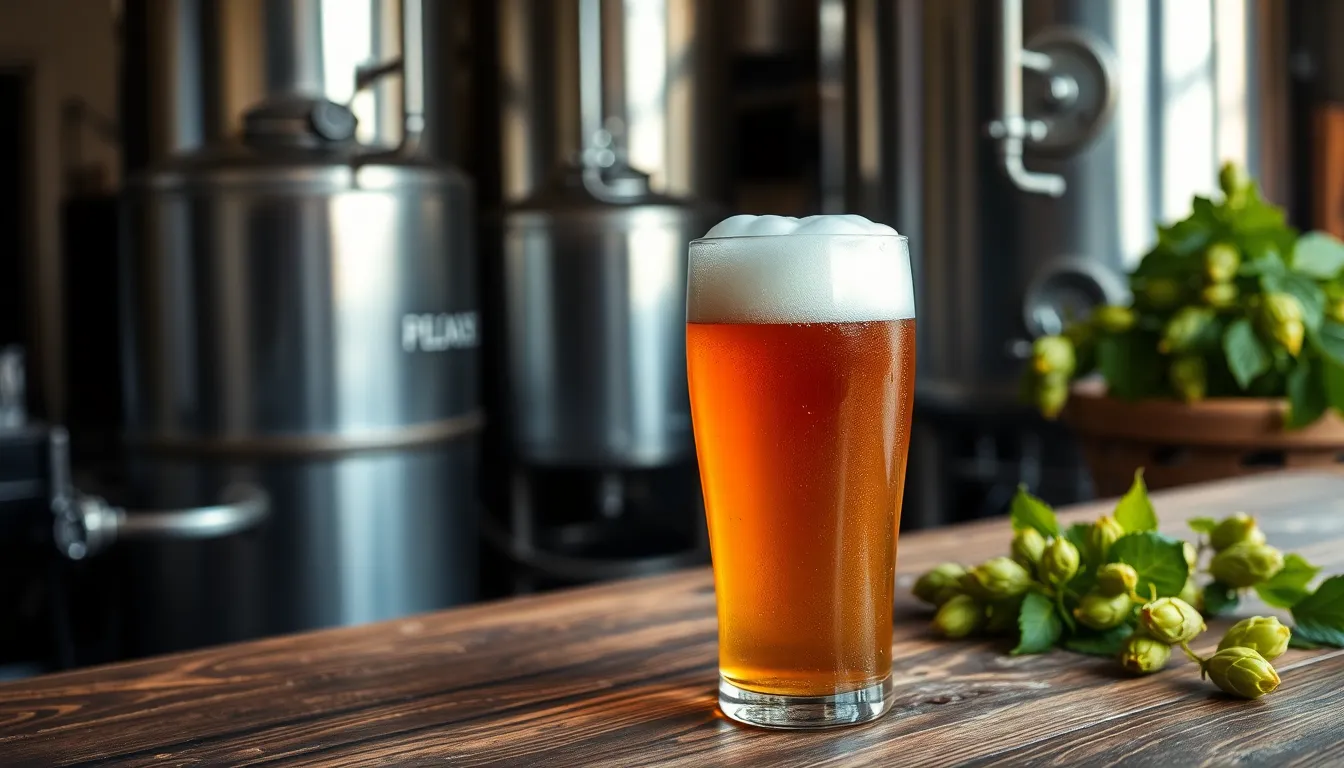Craft beer lovers often find themselves in a passionate debate over one of the most popular styles: IPA beer. Short for India Pale Ale, this hoppy delight has taken the beer world by storm, captivating taste buds and igniting fervor among enthusiasts. But what exactly makes an IPA stand out in a crowded bar?
Table of Contents
ToggleWhat Is an IPA Beer?
India Pale Ale, commonly referred to as IPA, stands out among beer varieties for its distinct flavor profile and higher alcohol content. This craft beer style originated in England during the 19th century, primarily intended for export to India. Breweries added extra hops to help preserve the beer during long ocean voyages.
Hops contribute significant bitterness and aroma to IPAs. Various hop varieties impart unique characteristics, ranging from citrus and pine to floral and herbal notes. These flavor complexities appeal to a wide audience, making IPAs a popular choice in craft beer circles.
IPAs typically have an alcohol by volume (ABV) ranging from 5.5% to 7.5%. The rich and robust flavor often masks the alcohol content, providing a smooth drinking experience. Many breweries produce different sub-styles, such as American IPA, New England IPA, and Double IPA, further enriching the IPA landscape.
American IPAs showcase bold hop flavors, whereas New England IPAs offer a hazier appearance and a juicier taste. Double IPAs, also known as Imperial IPAs, deliver more intense flavors and higher alcohol levels, often exceeding 7.5% ABV. Each variation attracts enthusiasts seeking diverse experiences.
Understanding what makes an IPA unique involves recognizing the balance between malt sweetness and hop bitterness. This harmony creates a refreshing and enjoyable drinking experience, appealing to both new beer drinkers and seasoned connoisseurs alike. As trends in brewing continue to evolve, the IPA remains a well-loved staple in the craft beer community.
History of IPA Beer

India Pale Ale (IPA) has a rich history that traces back to the 19th century, highlighting its significance in the brewing world.
Origins of IPA
IPAs originated in England, specifically in the late 1700s. Brewers crafted these beers for export to British colonial India. High hop content provided preservation during long sea voyages. Notably, extra hops contributed unique floral and fruity aromas, distinguishing IPAs from other ale styles. The first IPAs aimed to cater to British soldiers and colonists, combining durability with flavor.
Evolution Over Time
Over the decades, American brewers embraced the IPA style, leading to unique iterations. The craft beer movement in the 1980s sparked innovation, introducing new hops from the United States. American IPAs began to exhibit bold citrus and pine notes, emphasizing hop character. Additionally, variations like New England IPA emerged in the 2010s, offering hazy appearances and juicy flavors. This evolution reflected changing consumer preferences for hop-forward brewing, solidifying the IPA’s status in the craft beer landscape.
Types of IPA Beer
IPAs encompass a variety of styles, each offering distinct flavors and characteristics that appeal to different audiences. Three notable types include American IPA, New England IPA, and Double IPA.
American IPA
American IPAs showcase assertive hop profiles, often featuring citrus and pine aromas. Typically, these beers exhibit an ABV ranging from 5.5% to 7.5%. Medium to high bitterness makes them refreshing choices for enthusiasts seeking bold flavors. Popular hop varieties, such as Cascade and Centennial, impart unique taste experiences while maintaining a balanced malt backbone. Many breweries craft seasonal versions to highlight regional hop varieties, creating varied offerings throughout the year.
New England IPA
New England IPAs prioritize hazy appearances and juicy flavors, diverging from traditional IPAs. These beers typically boast lower bitterness levels, ranging between 40 to 60 IBUs. Soft mouthfeel contributes to their smoothness, making them easy to drink. Citra and Mosaic hops are frequently used to deliver tropical fruit notes, enhancing the flavor profile. This style gained momentum in the 2010s, captivating drinkers who prefer hop-forward yet mellow experiences.
Double IPA
Double IPAs, or Imperial IPAs, deliver intense hop aromas and higher alcohol content, typically between 7.5% and 10%. Brewers emphasize an aggressive hop character while balancing it with a sturdy malt foundation. This robust combination creates complex flavors, including resinous and herbal notes alongside sweet malt undertones. The style appeals to seasoned beer drinkers craving bold expressions, often resulting in limited releases that highlight unique hop combinations.
Flavor Profile of IPA Beer
IPAs offer a distinct and complex flavor profile that attracts many beer enthusiasts. Their unique characteristics originate primarily from the hops used during brewing.
Hops and Their Role
Hops are central to the IPA flavor profile, providing bitterness, aroma, and preservation qualities. Varieties such as Cascade, Centennial, and Simcoe deliver citrus, floral, and pine notes, enhancing the beer’s character. The addition of hops occurs at various brewing stages, influencing the final taste. Early hop additions contribute to bitterness, while late additions promote aromatic qualities. Some IPAs include dry hopping, which involves adding hops post-fermentation to intensify the aroma without increasing bitterness. This hop-forward approach differentiates each IPA style, creating a diverse range of experiences for drinkers.
Aroma and Taste Characteristics
Aroma and taste characteristics in IPAs vary significantly across styles, creating a layered drinking experience. Citrus aromas are prevalent in many American IPAs, often accompanied by notes of grapefruit, orange, and lemon. Floral elements from specific hops contribute to a refreshing profile, enhancing the overall experience. Some brewers emphasize malt sweetness to balance the hop bitterness, creating a smooth finish. New England IPAs tend to feature juicy flavors with a softer mouthfeel, while Double IPAs deliver intense hop experiences with higher bitterness. Overall, the combination of these elements shapes the essence of each IPA, catering to diverse palates and preferences.
Brewing Process of IPA Beer
The brewing process of IPA beer involves specific ingredients and steps that contribute to its unique characteristics.
Ingredients Involved
Hops, malt, yeast, and water form the foundation of IPA. Hops provide bitterness, aroma, and flavor, with varieties like Cascade and Simcoe yielding citrus and floral notes. Malt delivers the necessary sugars and adds sweetness that balances the hoppy bitterness. Yeast ferments the sugars, converting them into alcohol and carbon dioxide, while water plays a crucial role in brewing, impacting the overall flavor profile. Specific mineral content in water can accentuate different aspects of the beer, enhancing the final product.
Steps to Brew IPA
Brewing begins with mashing grains to extract sugars. Next, wort is created by boiling the mashed grains with hops, where bittering hops are added early and aromatic hops later. Cooling the wort follows, preparing it for yeast. After pitching yeast, fermentation occurs over several days, allowing flavors to develop. Once fermentation completes, the beer is often dry hopped for additional aroma. Finally, the beer undergoes conditioning before filtration and packaging. Each step significantly influences the final IPA offering.
IPAs continue to captivate beer lovers with their bold flavors and diverse styles. Each variation offers a unique experience that caters to different tastes and preferences. From the vibrant citrus notes of American IPAs to the hazy juiciness of New England IPAs, there’s an IPA for everyone.
The rich history and innovative brewing techniques behind IPAs contribute to their enduring popularity. As craft breweries experiment with new hop varieties and brewing methods, the IPA category is likely to evolve further. This dynamic nature ensures that enthusiasts will always find something new and exciting in the world of India Pale Ales.






